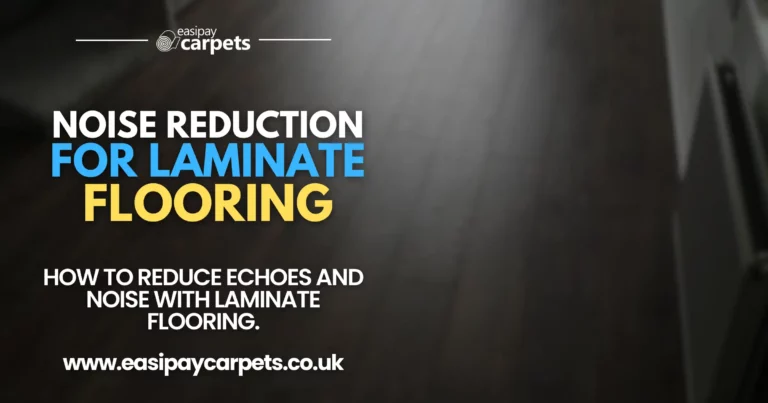

How To Reduce Noise With Laminate Flooring
Laminate flooring is a popular choice for its affordability, durability, and ease of installation. However, one common downside is that it can be noisy, especially in high-traffic areas or large rooms where sound tends to echo. Fortunately, there are several effective strategies to reduce noise with laminate flooring, from selecting the right underlay to adding soundproofing elements. In this guide, we’ll explore the best tips for minimizing noise, creating a quieter and more comfortable living space.
Why Does Laminate Flooring Cause Noise?
Before diving into noise reduction tips, it’s important to understand why laminate flooring can be noisy:
Floating Floor Installation:
- Description: Laminate flooring is often installed as a “floating floor,” meaning it isn’t glued or nailed to the subfloor. This can cause the flooring to move slightly when walked on, creating noise.
- Impact: Movement leads to creaking, clicking, or hollow sounds, especially if the subfloor is uneven.
Hard Surface:
- Description: Laminate flooring is a hard surface, which can amplify sound when objects are dropped or when there is foot traffic.
- Impact: The hard surface doesn’t absorb sound well, causing footsteps, pet nails, and dropped items to create more noise.
Lack of Sound Absorption:
- Description: Unlike carpet, laminate flooring doesn’t have fibres to absorb sound, resulting in echoes and louder noise levels in a room.
- Impact: This is particularly noticeable in large or open spaces where sound can bounce off walls and floors.
Tips for Reducing Noise with Laminate Flooring
There are several effective ways to reduce noise and improve the acoustics of a room with laminate flooring. Here are the top tips to help you achieve a quieter, more peaceful environment:
1. Choose the Right Underlay for Noise Reduction
- Tip: Invest in a high-quality underlay specifically designed for sound absorption and noise reduction.
- Why It Works: The underlay provides a cushion between the subfloor and the laminate, reducing the impact noise and helping to absorb sound. Look for underlays with a high Sound Transmission Class (STC) or Impact Insulation Class (IIC) rating for the best results.
- Best Options: Foam underlay with a sound barrier layer, rubber underlay, or cork underlay are all excellent choices for noise reduction.
2. Use Area Rugs and Runners
- Tip: Place area rugs, runners, or carpet mats in high-traffic areas or large rooms with laminate flooring.
- Why It Works: Rugs and runners help absorb sound, reduce echo, and provide a softer surface to walk on, minimizing the noise created by footsteps or moving furniture.
- Best Locations: Hallways, living rooms, dining areas, and bedrooms benefit the most from rugs and runners for noise reduction.
3. Add Furniture and Soft Furnishings
- Tip: Incorporate furniture, curtains, cushions, and soft furnishings into your room design to help dampen sound.
- Why It Works: Soft furnishings absorb sound waves, reducing echo and noise levels. More furniture and fabric in a room can help diffuse sound and create a quieter atmosphere.
- Best Choices: Consider adding upholstered furniture, thick curtains, cushions, throws, and padded wall art to soften the acoustics.
4. Install Acoustic Underlayment
- Tip: If you’re installing new laminate flooring or replacing an existing floor, consider using acoustic underlayment designed specifically to reduce noise.
- Why It Works: Acoustic underlays are thicker and denser than standard options, providing better sound insulation and preventing noise from traveling between floors.
- Best Choices: Look for underlays made from rubber, cork, or felt, which offer superior soundproofing benefits.
5. Seal Gaps and Joints
- Tip: Ensure that gaps and joints around the perimeter of the room are properly sealed with silicone caulk or acoustic sealant.
- Why It Works: Sealing gaps prevents sound from traveling through cracks and crevices, helping to reduce overall noise levels.
- Best Locations: Pay attention to the gaps around walls, doorways, and floor transitions to minimize sound transmission.
6. Use Felt Pads on Furniture Legs
- Tip: Attach felt pads or rubber caps to the bottom of furniture legs to prevent scraping and dragging sounds on laminate flooring.
- Why It Works: Felt pads and rubber caps provide a buffer between furniture and the floor, reducing impact noise and preventing scratches.
- Best Applications: Chairs, tables, sofas, and heavy furniture should all have protective pads to minimize noise.
7. Install Soundproofing Curtains or Panels
- Tip: Consider installing soundproofing curtains or acoustic panels on walls or windows to reduce noise and echo.
- Why It Works: Soundproofing curtains and panels are designed to absorb and dampen sound waves, reducing echo and noise levels in a room with laminate flooring.
- Best Locations: Large windows, bare walls, and echo-prone areas are ideal for soundproofing treatments.
8. Use Soundproofing Foam or Insulation
- Tip: For a more permanent solution, consider installing soundproofing foam or insulation under the subfloor or within walls.
- Why It Works: Soundproofing foam or insulation helps to block sound transmission, reduce vibrations, and create a quieter environment, especially in multi-story buildings.
- Best Applications: This is particularly effective in reducing noise between floors in apartments or homes with multiple levels.
9. Opt for Thicker Laminate Planks
- Tip: Choose thicker laminate planks (12mm or thicker) when installing new flooring, as they provide better sound insulation compared to thinner planks.
- Why It Works: Thicker planks are more solid and dense, which helps to reduce impact noise and create a quieter surface.
- Best Choices: High-quality, thicker laminate options often come with built-in underlays, further enhancing noise reduction.
10. Keep the Subfloor Level and Smooth
- Tip: Ensure that the subfloor is level, smooth, and free of debris before installing laminate flooring.
- Why It Works: An uneven subfloor can cause the laminate planks to move and create noise. A level and clean subfloor provide a stable base, minimizing creaking and clicking sounds.
- Best Practices: Use a self-levelling compound to address uneven subfloor issues before installing laminate flooring.
Soundproofing Solutions for Specific Areas
1. High-Traffic Hallways:
- Solution: Use high-density foam underlay or rubber underlay for added cushioning and noise reduction. Place runners along the hallway to absorb impact noise.
2. Open-Concept Living Areas:
- Solution: Add large area rugs and soft furnishings like curtains, cushions, and wall art to dampen sound and prevent echo.
3. Bedrooms and Quiet Spaces:
- Solution: Install soundproofing curtains and add thick area rugs to create a quiet, peaceful environment.
4. Multi-Story Homes or Apartments:
- Solution: Use acoustic underlays, soundproofing foam, or insulation under the subfloor to minimize noise transmission between floors.
Conclusion
While laminate flooring is known for its durability and style, it can sometimes create unwanted noise. By following these tips for reducing noise with laminate flooring, you can enjoy the benefits of laminate without the drawbacks of excessive noise. From choosing the right underlay and adding area rugs to installing soundproofing curtains and using felt pads on furniture, there are numerous ways to create a quieter, more comfortable space with laminate flooring.
Easipay Carpets can help you get brand new flooring without the high up-front cost – by simply letting you spread the cost of the flooring over time instead. There’s no interest on our plans so you aren’t spending a penny more than you would buying it outright and we include underlay, door trims, carpet grippers and laminate beading for free. Prices start from just £10 per week!
It starts with a free home appointment and quote, to get booked in at a time that suits you, tap the “Get Started” button below and fill out the contact form!
Still Got Questions? Here's 10 FAQs!
You can reduce noise by using high-quality underlay, adding area rugs, using soundproofing curtains, and installing felt pads on furniture legs.
Acoustic underlays made from rubber, cork, or felt are the best for reducing noise and providing sound insulation for laminate flooring.
Yes, rugs and runners help absorb sound, reduce echo, and minimize impact noise on laminate flooring.
Prevent echo by adding soft furnishings like rugs, curtains, cushions, and upholstered furniture to help absorb sound.
Thicker laminate planks (12mm or more) provide better sound insulation compared to thinner planks, reducing noise and impact sounds.
Yes, soundproofing panels or curtains can be installed on walls or windows to reduce noise and echo in rooms with laminate flooring.
Yes, installing soundproofing foam or insulation under the subfloor can help reduce noise transmission between floors in multi-story buildings.
Yes, an uneven subfloor can cause laminate planks to move and create noise. Ensure the subfloor is level before installation.
Yes, rubber-backed rugs can reduce noise, but ensure they are breathable to prevent moisture build up that could damage the laminate.
No, wood glue is not typically used to reduce noise in laminate flooring. Laminate flooring is designed to be a floating floor with room to expand and contract, and gluing the planks can interfere with this natural movement.
Instead, focus on using high-quality underlays, rugs, and soundproofing materials to effectively reduce noise without compromising the flooring’s flexibility and durability.




